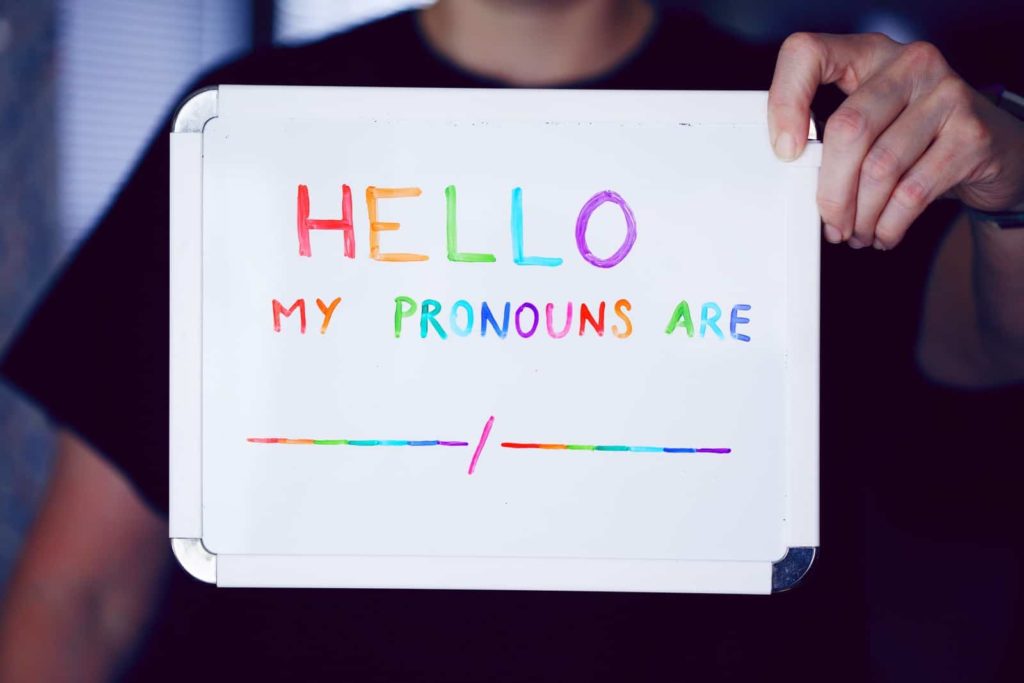Gender Neutral Pronouns: What They Are & How to Use Them

The use of gender-neutral pronouns is becoming increasingly common in modern society, reflecting a growing recognition and respect for individuals who do not identify strictly as male or female. According to a 2019 Pew Research Center survey, about 35% of Generation Z (ages 7-22 at the time) reported knowing someone who uses gender-neutral pronouns like “they” instead of “he” or “she” (Pew Research). Acceptance of gender-neutral pronouns tends to decrease among older generations. Additionally, Merriam-Webster named “they” as the Word of the Year in 2019, highlighting the increasing significance of gender-neutral language in everyday communication (UCLA Gender Neutral).
Understanding and correctly using gender-neutral pronouns is not just a matter of grammar—it is a way to foster inclusivity and respect for all individuals, helping to create a more accepting and diverse society.
Why the resistance to gender pronouns?
What are gender neutral pronouns? Gender neutral pronouns are pronouns that don’t specifically refer to any one gender. They can be used to refer to people of any gender, whether that be male, female, non-binary, or any other gender identity.
What is the problem with gender neutral pronouns?
There are a few different issues that can arise when using gender neutral pronouns. Firstly, some people may not be familiar with them, which can lead to confusion. Secondly, they are not always grammatically correct, which can make them difficult to use in certain situations. Finally, some people may simply prefer to use gendered pronouns, which can make using gender neutral pronouns feel forced or unnatural.
How do you use gender neutral pronouns?
When using gender neutral pronouns, it is important to be clear and concise. Be sure to explain what they are and why you are using them. It is also important to be aware of the grammar rules surrounding them, as they can be tricky to use
Gender-neutral Pronouns, and How to Use Them
Pronouns are an important part of the language. They allow us to refer to people or objects without having to use their names. This can be helpful in many situations, such as when we want to avoid repeating someone’s name too often, or when we don’t know the name of the person or object we’re referring to.
Here is a list of gender-neutral pronouns:
- He/She — Zie, Sie, Ey, Ve, Tey, E
- Him/Her — Zim, Sie, Em, Ver, Ter, Em
- His/Her — Zir, Hir, Eir, Vis, Tem, Eir
- His/Hers — Zis, Hirs, Eirs, Vers, Ters, Eirs
- Himself/Herself — Zieself, Hirself, Eirself, Verself, Terself, Emself

As you can see, there are many different options to choose from. The best way to decide which pronoun to use is to ask the person you’re referring to which one they prefer. If you’re unsure, it’s also perfectly fine to use they/them pronouns.
How should I use gender neutral pronouns in emails?
When writing an email, it is important to use gender-neutral language whenever possible. This means avoiding pronouns such as “he” or “she” when you do not know the gender of the person you are writing to.
Here are some example:
- “I spoke to the sales director and they said they’d get back to me.”
- “I think someone left their mobile phone behind.”
- “Who’s in charge of that sales process? I’ll email them.”

What’s the “right” way to learn someone’s pronouns?
When you first meet someone, you want to make sure that they feel comfortable. Make sure that they are OK – so it’s perfectly fine to ask…as transgender, agender, or nonbinary…
Instead, introduce yourself with your own pronouns: “Hi, I’m Maria, and my pronouns are her/she.”
If the person you’re speaking to doesn’t yet know their pronouns, that’s OK, too. You can simply use your own pronouns when referring to them.
“Hi, I’m pronoun-less until I figure it out. Do you mind if I ask what your pronouns are?”
“I use they/them pronouns.”